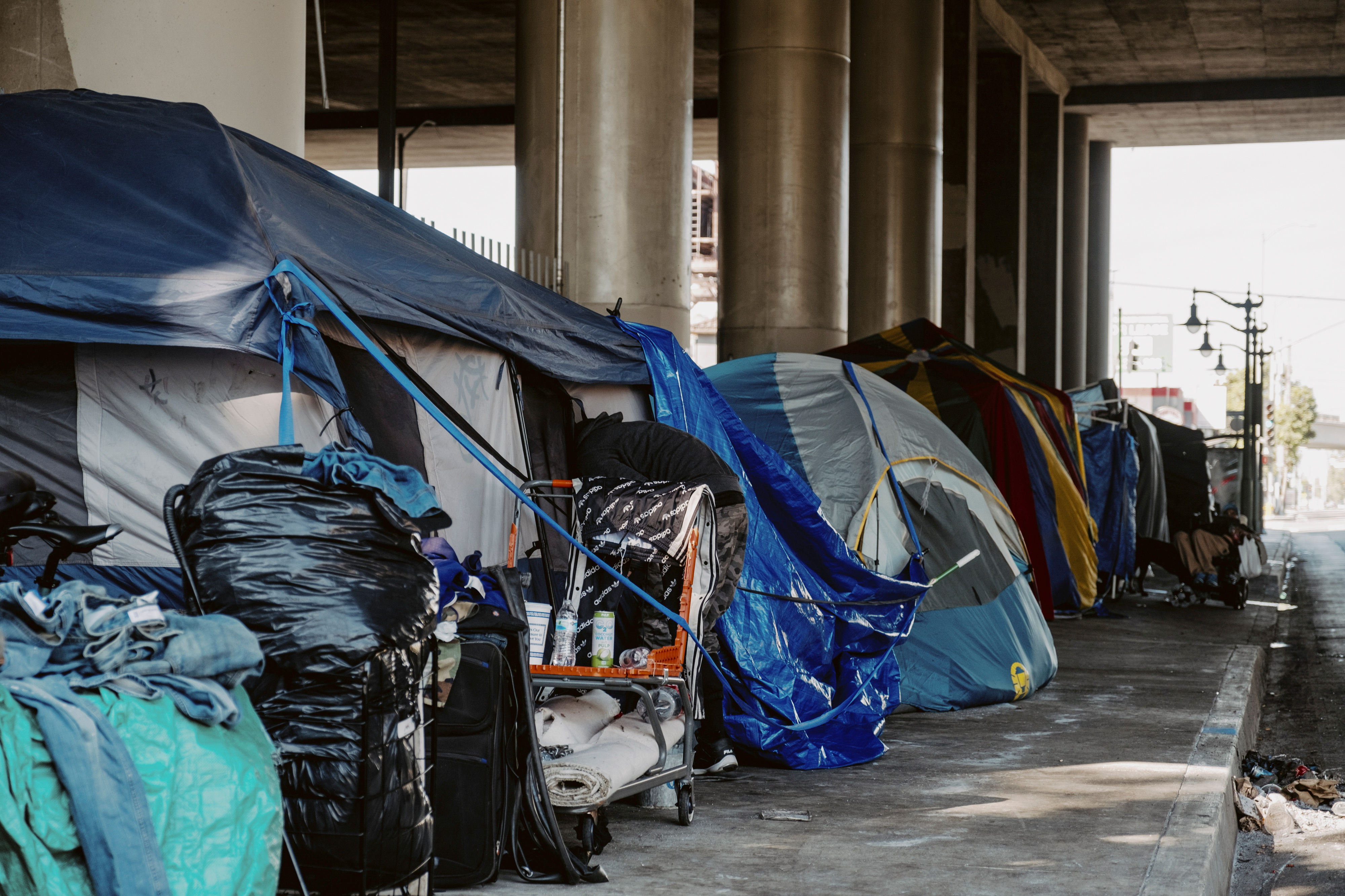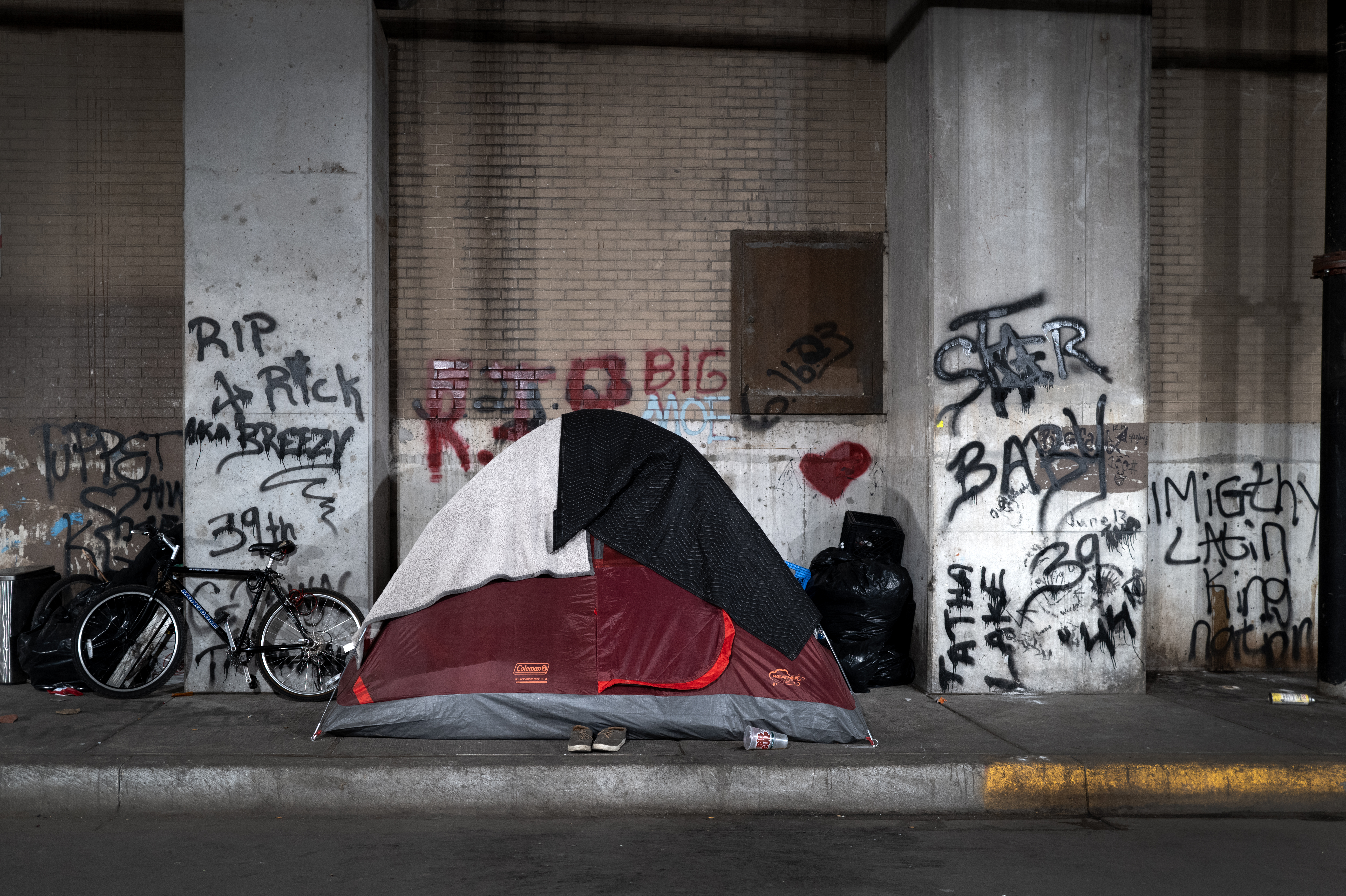Local officials and advocates in California are divided over Gov. Gavin Newsom’s recent executive order requiring state agencies to remove homeless encampments on public property, leaving the homeless community caught in the middle and uncertain where they will go.
In June, the Supreme Court ruled that punishing homeless people for sleeping on public property does not violate the Eighth Amendment’s prohibition against cruel and unusual punishment. According to an assessment provided to Congress last year by the Department of Housing and Urban Development, there were about 180,000 homeless people across the state, making California’s homeless population one of the highest in the nation along with New York’s, Florida’s and Washington’s.
In an effort to address the rising levels of homelessness, Newsom, a Democrat, ordered state agencies to adopt plans to remove homeless encampments across the state — one of the most direct reactions to the Supreme Court’s decision and a path other states could soon follow.
While local governments are not forced to comply, Newsom said in a press conference on Thursday that he will withhold funding from cities and counties for not clearing encampments next year.
Newsom has pointed out that his administration has invested billions across multiple state agencies to provide services to homeless people, including more than $9 billion for programs aimed at helping local governments move them out of camps and into housing. The investments — as well as the new authority that the Supreme Court gave to cities — will provide the tools needed to carry out the order, he said.
“No more excuses,” Newsom said in a July 25 post on X. “We’ve provided the time. We’ve provided the funds. Now it’s time for locals to do their job.”
Get Tri-state area news delivered to your inbox. Sign up for NBC New York's News Headlines newsletter.
But members of the homeless community say they have nowhere to go.
“It’s absolute mayhem and craziness,” said Jeni Shurley, a member of the homeless community in Los Angeles.
“I honestly feel like I need to leave the country, because I have so desperately searched the entire country trying to find some kind of a solution, literally gone coast to coast,” she added.
Shurley, 48, said she has been homeless for the decade, holding down a string of temporary and itinerant jobs in one location or another in Oregon, Colorado, Louisiana, Missouri, Washington, D.C., and now California, while also suffering serious health problems.
After Newsom announced his executive order on July 25, Shurley said she considered moving to another country because she didn’t want to be criminalized for being homeless.
“I have done everything I can, every program that’s been offered,” she said. “I’ve taken up on it, and I haven’t gotten any assistance that I need whatsoever. I feel like I’m just a rock in the river full of money and I can’t touch $1 of it.”
Last year, the state had about 71,000 shelter beds available — less than half of the more than 180,000 beds needed to shelter the state’s homeless population, according to the Public Policy Institute of California, a nonprofit, nonpartisan think thank, citing the HUD report. This shortage makes Newsom’s order that much more challenging for localities.
Homeless shelters across the state will have to extend their services to accommodate the influx of people coming off the streets, but many say they don’t have adequate resources, even with the state’s investments.
Mission Action, which provides emergency shelter and advocates for homeless people in San Francisco’s Mission District, said in a statement to NBC News that it’s concerned the city doesn’t have enough emergency shelter beds for the population living in encampments.
The organization’s 91-bed adult emergency shelter was already at capacity before the order was announced, and another 80-bed family shelter has just four beds available, it said.
“If the city is unable to provide emergency shelter to those who need and want shelter, then essentially, we are criminalizing the very act of being unhoused,” Laura Valdez, organization’s executive director, said in the statement.
A Newsom spokesperson, however, told NBC News that the concerns over resources are misguided.
“Local governments have been provided ample funding to help address this issue within their communities,” said Tara Gallegos, Newsom’s deputy director of communications, echoing the governor’s statement that there is no excuse for communities to neglect the encampments.
As shelters in the San Francisco area continued to be nearly full, Mayor London Breed announced a directive earlier this month to provide relocation support for homeless people, including bus tickets, to help them move elsewhere. Breed’s office said she has expanded the number of shelter beds by over 60% during her tenure, but shelters across the city have continued to fill up rapidly as the city’s homeless population has risen.
San Francisco, the state's fourth-largest city, which has municipal and county governments serving the same geography and population, has about 8,300 homeless people.
Santa Clara County, home to the wealth of Silicon Valley and to the state's third-largest city, San Jose, had nearly 10,000 homeless people, as of its latest count in 2023. San Diego County, which has the state’s second-largest city, has about 10,600 homeless people. And Los Angeles County, home to the nation's second-largest city, has about 75,300.
In a move championed by Mayor Todd Gloria, the city of San Diego last year banned camping on sidewalks and launched Newsom-style sweeps that leaders and organizers in neighboring communities said sent homeless people their way.
The Los Angeles County Board of Supervisors passed a motion stating that individuals taken from encampments will not be taken to jail, despite the potential for penalties or citations for noncompliance with Newsom’s order.
“Simply having law enforcement performing campus sweeps, in my opinion, does nothing to deliver permanent and lasting results. It just shuffles the problem around, and that’s why my constituents want permanent results,” Los Angeles County Supervisor Kathryn Barger, a Republican, told NBC News.
For Barger, the permanent solution is housing, but the question remains whether the city is able to provide it.
Newsom’s order is an extension of the work already being done in Los Angeles to remove encampments, but adds an extra layer of coordination between state agencies, she said. Barger added that the city was working to maintain the trust of the homeless community while working to dismantle the camps.
Other officials applauded Newsom for addressing the encampments with the executive order.
Sacramento Mayor Darrell Steinberg, a Democrat, said the governor’s efforts to address mental health and homelessness are unlike anything he has seen done in the past 30 years.
Steinberg authored a bill as a state senator in 2004 aimed at taxing the wealthy to help provide mental health services to homeless people and others. Later approved by voters as a ballot initiative, the measure placed a 1% tax on personal incomes above $1 million to fund such services across the state. But it did not provide direct funding for homeless shelters, which is the fundamental thing advocates and shelters say they’re lacking following Newsom’s order.
Despite concerns about resources, Steinberg says the governor’s order mirrored what Sacramento has been trying to accomplish for years.
“People living in these large encampments, it’s not safe, it’s not healthy for them or for our community,” he said.
His city was trying to combine “compassion and enforcement with aggressively adding more beds, more services and permanent housing for people,” he said.
Last year, the city saw a 29% decrease in homelessness from the previous year, something Steinberg said is due to its commitment to address health and safety concerns across the community. While Sacramento has a smaller population than Los Angeles and San Francisco, the city also saw a 49% decline in unsheltered homelessness, one of the biggest drops across the state.
Still, Steinberg said they’re not celebrating a victory given the number of people living in the streets. The order, he said, is a step “heading in the right direction.”
“We just have to keep providing more alternatives for people, and people need to be willing to accept them,” Steinberg said. “But it’s not perfect, and I’m going to continue to argue and push in my city to make sure we have something for as many people as possible.”
This article first appeared on NBCNews.com. More from NBC News:



